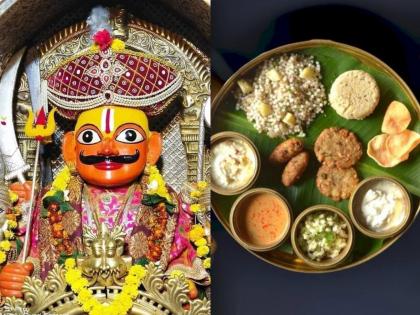Champa Shashthi 2025: What You Can Eat During the Khandoba Navratri Fast
By Lokmat Times Desk | Updated: November 20, 2025 23:30 IST2025-11-20T23:28:05+5:302025-11-20T23:30:17+5:30
Margashrisha month begins tomorrow Nov 21st 2025, lord Khandoba avtar of lord shiva navratri begins, this day is also celebrated ...

Champa Shashthi 2025: What You Can Eat During the Khandoba Navratri Fast
Margashrisha month begins tomorrow Nov 21st 2025, lord Khandoba avtar of lord shiva navratri begins, this day is also celebrated as dev deepavali in some parts of India. Khandoba Navratra is popularly known as Martand Bhairav Shadratrotsav. This is a six-day celebration that begins on November 21 and ends of December 1 with Champa Shashthi. During this period, devotees often observe fasting in specific dietary practices.
Champa Shashthi Fasting Rules
- Fruits: Fresh fruits are commonly consumed during the fast. This includes bananas, apples, and seasonal fruits.
- Vegetables: Certain vegetables like potatoes and sweet potatoes can be included, but it's essential to avoid root vegetables that are not permitted during fasting.
- Grains: Many devotees consume sabudana (tapioca pearls) and singhara (chestnut flour) dishes, which are light and easily digestible.
- Dairy Products: Milk, yogurt, and paneer can be included in meals as they provide necessary nutrients while adhering to fasting rules.
- Snacks: Light snacks such as roasted peanuts or khichdi made with sabudana or singhara flour are popular choices.
Avoid: Regular grains (like rice and wheat), non-vegetarian food, and alcohol should be strictly avoided during the fasting period.
During Champa Shashthi, devotees engage in various rituals:
- Morning Rituals: Early morning purification rituals including bathing and visiting temples.
- Offerings: Daily offerings at temples may include fruits, vegetables, turmeric powder, and other natural items.
- Lighting Diyas: Devotees light nine oil lamps (diyas) in front of the deity as part of the worship process.
The festival is not only a time for fasting but also a period for spiritual reflection and community engagement among devotees. Observing the fast with dedication is believed to bring blessings and prosperity
Open in app